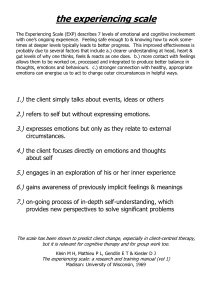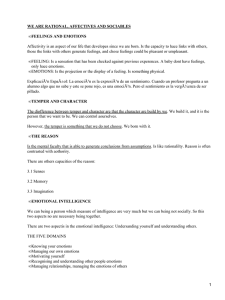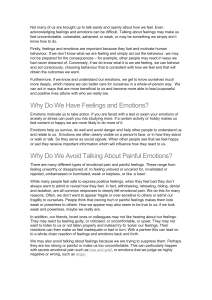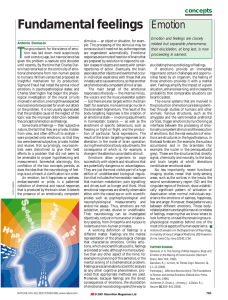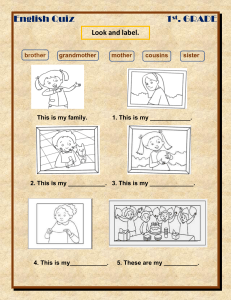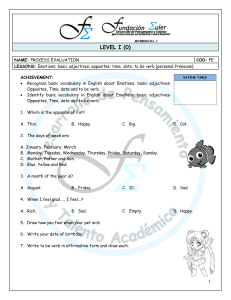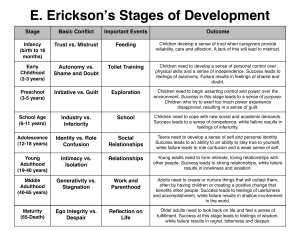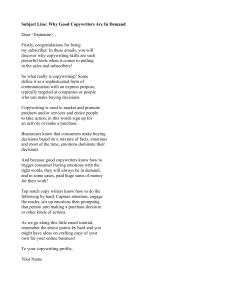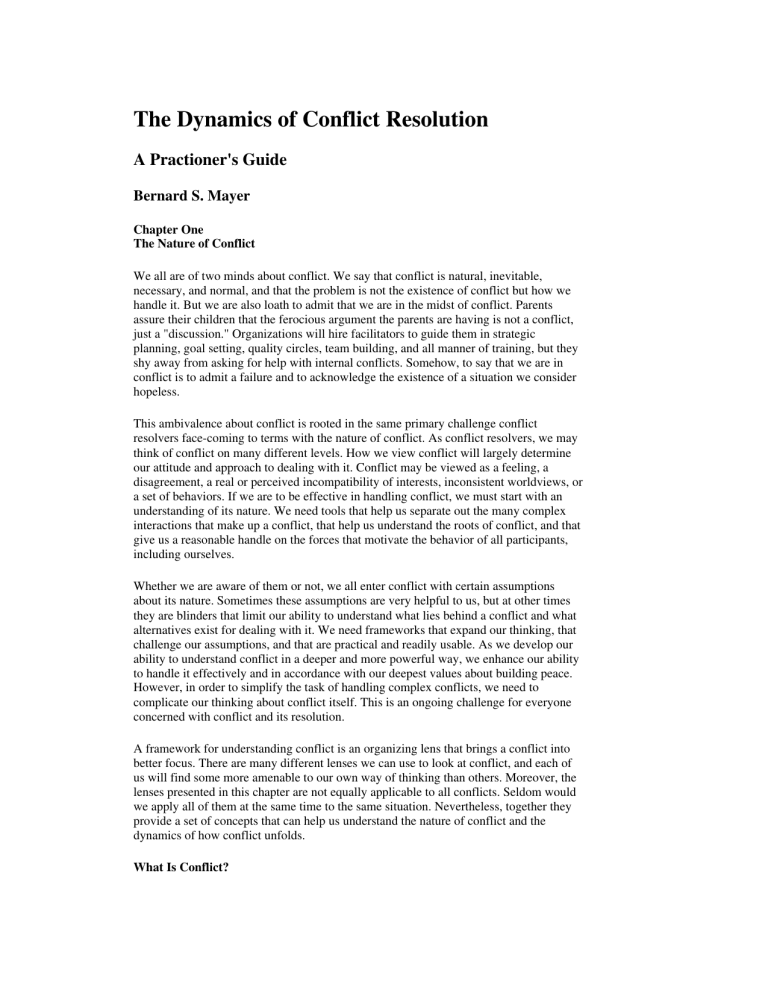
The Dynamics of Conflict Resolution A Practioner's Guide Bernard S. Mayer Chapter One The Nature of Conflict We all are of two minds about conflict. We say that conflict is natural, inevitable, necessary, and normal, and that the problem is not the existence of conflict but how we handle it. But we are also loath to admit that we are in the midst of conflict. Parents assure their children that the ferocious argument the parents are having is not a conflict, just a "discussion." Organizations will hire facilitators to guide them in strategic planning, goal setting, quality circles, team building, and all manner of training, but they shy away from asking for help with internal conflicts. Somehow, to say that we are in conflict is to admit a failure and to acknowledge the existence of a situation we consider hopeless. This ambivalence about conflict is rooted in the same primary challenge conflict resolvers face-coming to terms with the nature of conflict. As conflict resolvers, we may think of conflict on many different levels. How we view conflict will largely determine our attitude and approach to dealing with it. Conflict may be viewed as a feeling, a disagreement, a real or perceived incompatibility of interests, inconsistent worldviews, or a set of behaviors. If we are to be effective in handling conflict, we must start with an understanding of its nature. We need tools that help us separate out the many complex interactions that make up a conflict, that help us understand the roots of conflict, and that give us a reasonable handle on the forces that motivate the behavior of all participants, including ourselves. Whether we are aware of them or not, we all enter conflict with certain assumptions about its nature. Sometimes these assumptions are very helpful to us, but at other times they are blinders that limit our ability to understand what lies behind a conflict and what alternatives exist for dealing with it. We need frameworks that expand our thinking, that challenge our assumptions, and that are practical and readily usable. As we develop our ability to understand conflict in a deeper and more powerful way, we enhance our ability to handle it effectively and in accordance with our deepest values about building peace. However, in order to simplify the task of handling complex conflicts, we need to complicate our thinking about conflict itself. This is an ongoing challenge for everyone concerned with conflict and its resolution. A framework for understanding conflict is an organizing lens that brings a conflict into better focus. There are many different lenses we can use to look at conflict, and each of us will find some more amenable to our own way of thinking than others. Moreover, the lenses presented in this chapter are not equally applicable to all conflicts. Seldom would we apply all of them at the same time to the same situation. Nevertheless, together they provide a set of concepts that can help us understand the nature of conflict and the dynamics of how conflict unfolds. What Is Conflict? Conflict may be viewed as occurring along cognitive (perception), emotional (feeling), and behavioral (action) dimensions. This three-dimensional perspective can help us understand the complexities of conflict and why a conflict sometimes seems to proceed in contradictory directions. Conflict as Perception As a set of perceptions, conflict is a belief or understanding that one's own needs, interests, wants, or values are incompatible with someone else's. There are both objective and subjective elements to this cognitive dimension. If I want to develop a tract of land into a shopping center, and you want to preserve it as open space, then there is an objective incompatibility in our wants. If I believe that the way you desire to guide our son's educational development is incompatible with my philosophy of parenting, then there is at least a significant subjective component. What if only one of us believes an incompatibility to exist, are we still in conflict? As a practical matter, I find it useful to think of conflict as existing if at least one person believes it to exist. If I believe us to have incompatible interests, and act accordingly, then I am engaging you in a conflict process whether you share this perception or not. Conflict as Feeling Conflict also involves an emotional reaction to a situation or interaction that signals a disagreement of some kind. The emotions felt might be fear, sadness, bitterness, anger, or hopelessness, or some amalgam of these. If we experience these feelings in regard to another person or situation, we feel that we are in conflict-and therefore we are. As a mediator, I have sometimes seen people behave as if they were in great disagreement over profound issues, yet I have not been able to ascertain exactly what they disagreed about. Nonetheless, they were in conflict because they felt they were. And in conflicts, it does not take two to tango. Often a conflict exists because one person feels in conflict with another, even though those feelings are not reciprocated by or even known to the other person. The behavioral component may be minimal, but the conflict is still very real to the person experiencing the feelings. Conflict as Action Conflict also consists of the actions that we take to express our feelings, articulate our perceptions, and get our needs met in a way that has the potential for interfering with someone else's ability to get his or her needs met. This conflict behavior may involve a direct attempt to make something happen at someone else's expense. It may be an exercise of power. It may be violent. It may be destructive. Conversely, this behavior may be conciliatory, constructive, and friendly. But, whatever its tone, the purpose of conflict behavior is either to express the conflict or to get one's needs met. Again, the question of reciprocity exists. If you write letters to the editor, sign petitions, and consult lawyers to stop my shopping center, and I do not even know you exist, are we in conflict? Can you be in conflict with me if I am not in conflict with you? Theory aside, I think the practical answer to both of these questions is yes. Obviously, the nature of a conflict in one dimension greatly affects its nature in the other two dimensions. If I believe you are trying to hurt me in some way, I am likely to feel as though I am in conflict with you, and I am also apt to engage in conflict behaviors. Also, none of these dimensions is static. People can go rapidly in and out of conflict, and the strength or character of conflict along each dimension can change quickly and frequently. And even though each of the three dimensions affects the others, a change in the level of conflict in one dimension does not necessarily cause a similar change in the other dimensions. Sometimes an increase in one dimension is associated with a decrease in another dimension. For example, the emotional component of conflict occasionally decreases as people increase their awareness of the existence of the dispute and their understanding of its nature. This is one reason why conflict can seem so confusing and unpredictable. What about a situation where no conflict perceptions, emotions, or behaviors are present but where a tremendous conflict potential exists? Perhaps you are unaware of my desire to build a shopping center, and I am unaware of your plans for open space. Are we in conflict? We may soon be, but until conflict exists on one of the three dimensions, I believe it is more productive to think in terms of potential conflict than actual conflict. The potential for conflict almost always exists among any individuals or institutions that interact. Unless people want to think of themselves as constantly in conflict with everyone in their lives, it is more useful to view conflict as existing only when it clearly manifests itself along one of the three dimensions. Can social systems-organizations, countries, and communities-as well as individuals be in conflict, particularly along the emotional or cognitive dimensions? Although there are some significant dangers to attributing personal characteristics or motivational structures to systems, practically speaking I think systems in conflict often experience that conflict on all three dimensions. Although we might better use terms like culture, ethos, public opinion, or popular beliefs to signify the greater complexity and different nature of these dimensions in social systems, conflict among groups clearly has cognitive and affective dimensions as well as a behavioral dimension. Is there an emotional and a perceptual aspect to the conflict between Iraq and the United States? Of course, and we cannot understand the nature of the conflict if we do not deal with these aspects. This does not mean that every individual member of each country shares the same feelings or perceptions or even that a majority do. Instead, it means that the conflict evokes certain reactions and attitudes from the dominant leaders and a significant number of people in each society. Similarly, when we look at conflicts between union and management, environmental groups and industry associations, Democrats and Republicans, it is important to understand the attitudes, feelings, values, and beliefs that these groups have toward each other if we are to understand what is occurring. By considering conflict along the cognitive, emotional, and behavioral dimensions, we can begin to see that it does not proceed along one simple, linear path. When individuals or groups are in conflict, they are dealing with different and sometimes contradictory dynamics in these different dimensions, and they behave and react accordingly. This accounts for much of what appears to be irrational behavior in conflict. Consider this not unusual workplace dispute: Two employees are assigned to work together on a project and soon find themselves in a conflict over whether they are each pulling their weight and passing along important information to each other. They engage in a fairly public shouting match, and they each complain to their supervisor. The supervisor sits them both down, and they agree on a workload division and certain behavioral standards, to which they then seem to adhere. Has the conflict been resolved? It may have been alleviated along the behavioral dimension. But each goes away from this meeting feeling victimized by the other and unappreciated by the boss. One of the employees decides that these feelings just result from the nature of the job and believes that the immediate conflict is over, but the other continues to see the conflict being acted out every time the other person comes late for a meeting or sends a terse e-mail. Thus progress has been made in the behavioral dimension, the emotional dimension is if anything worse, and there are contradictory developments along the cognitive dimension. This kind of result is not unusual in conflict, and it drives people to behave in apparently inconsistent ways. These employees may cease their overtly conflictual behavior, but the tension between them may actually increase. What Causes Conflict? Conflict has many roots, and there are many theories that try to explain these origins. Conflict is seen as arising from basic human instincts, from the competition for resources and power, from the structure of the societies and institutions people create, from the inevitable struggle between classes. Even though there is something to be said for most of these theories, they are not always helpful to us as we contend with conflict. What we need is a framework that helps us use some of the best insights of different conflict theories in a practical way. If we can develop a usable framework for understanding the sources of conflict, we can create a map of conflict that can guide us through the conflict process. When we understand the different forces that motivate conflict behavior, we are better able to create a more nuanced and selective approach to handling conflict. The wheel of conflict, illustrated in Figure 1.1, is one way of understanding the forces that are at the root of most conflicts. This conceptualization of the sources of conflict has arisen out of my work and conversations with my colleagues at CDR Associates and is derivative of the circle of conflict developed by one of my partners, Christopher Moore (see Moore, 1986, 1996). At the center of all conflicts are human needs. People engage in conflict either because they have needs that are met by the conflict process itself or because they have (or believe they have) needs that are inconsistent with those of others. I discuss the continuum of human needs later in this chapter. My major point for now is that people engage in conflict because of their needs, and conflict cannot be transformed or settled unless these needs are addressed in some way. Needs do not exist in a vacuum, however. They are embedded in a constellation of other forces that can generate and define conflict. In order to effectively address needs, it is usually necessary to work through some of these other forces, which affect how people experience their needs and how these needs have developed. There are five basic forces, or sources of conflict: the ways people communicate, emotions, values, the structures within which interactions take place, and history (see Figure 1.1). Let's examine each of these sources further. Communication Humans are very imperfect communicators. Sometimes this imperfection generates conflict, whether or not there is a significant incompatibility of interests, and it almost always makes conflict harder to solve. Human communication has inspired a large literature and multiple fields of study, and I will discuss communication as a resolution tool later. The main thing to consider here is how hard it is for individuals to communicate about complex matters, particularly under emotionally difficult circumstances. We should keep reminding ourselves just how easy it is for communication to go awry. Conflict frequently escalates because people act on the assumption that they have communicated accurately when they have not. When they learn that others are acting on the basis of different information and assumptions, they often attribute this to bad faith or deviousness and not to the imperfections of human communication. Many factors may contribute to communication problems. Culture, gender, age, class, and environment significantly affect individuals' ability to communicate effectively. People often rely on inaccurate or incomplete perceptions, tend to form stereotypes, and carry into their communications conclusions drawn from former interactions or experiences. They are also inclined to try to solve problems before they understand them. The greater the duress a person is under, the harder it is for him or her to communicate (and often the more important it is as well). Sometimes communication takes more energy and focus than someone is able or willing to give at a critical point, and it is easy to become discouraged or hopeless about communicating effectively in serious conflicts. Despite all these problems, people can and do muddle through when they communicate, and they can work on improving communication, even in very intense conflicts. Communication is one of the greatest sources of both difficulty and hope in dealing with serious conflicts. Emotions Emotions are the energy that fuel conflict. If people could always stay perfectly rational and focused on how to best meet their needs and accommodate those of others, and if they could calmly work to establish effective communications, then many conflicts would either never arise or would quickly deescalate. But of course that is not human nature, even if many of us occasionally pretend that it is. At times emotions seem to be in control of behavior. Sometimes they are also a source of power for disputants. They contribute to the energy, strength, courage, and perseverance that allow people to participate forcefully in conflict. Emotions are generated both by particular interactions or circumstances and by previous experiences. When someone points a finger at us in conflict, we have a reaction based on the immediate context and meaning of that behavior, but we may also be reacting to all the times in the past when that gesture has been made at us in anger. In conflict it is often possible and necessary to work specifically on the emotional content of disputants' experience. This usually requires creating some opportunity to express and release emotions and to experience someone else's understanding and empathy. We often talk about the need to ventilate, to let an emotion out through a direct and cathartic expression of it. Often, however, ventilation is neither possible nor desirable. A direct expression of feelings may escalate a conflict. Instead, it may be necessary for disputants to discuss feelings without demonstrating them, to work toward establishing a safe environment for the expression of emotions, to let emotions out in safe increments, or to express them to a third party rather than directly to the other person. Sometimes (although this may go against some popular beliefs of our culture), it is simply necessary to suppress feelings until a more appropriate opportunity for dealing with them presents itself. Emotions fuel conflict, but they are also a key to deescalating it. Many emotions can prevent, moderate, or control conflict. Part of everyone's emotional makeup is the desire to seek connection, affirmation, and acceptance. A genuine expression of sadness or concern can be key to addressing conflict effectively. Another key in many conflicts is to find an adequate way of dealing with the feelings of all participants so that they are neither ignored nor allowed to escalate out of control. Sometimes it may be necessary to let a conflict escalate somewhat, enough to deal with emotions but not so much as to impair people's ability to eventually deal with the situation constructively. The art of dealing with conflict often lies in finding the narrow path between useful expression of emotions and destructive polarization. This is one reason why it is often helpful to employ the services of a third party. Values Values are the beliefs we have about what is important, what distinguishes right from wrong and good from evil, and what principles should govern how we lead our lives. When a conflict is defined or experienced as an issue of values, it becomes more charged and intractable. Because people define themselves in part by their core beliefs, when they believe these values are under attack, they feel they are being attacked. Similarly, it is hard for people to compromise when core beliefs are in play, because they feel they are compromising themselves or their integrity. Although some conflicts are inescapably about fundamental value differences, more often disputants have a choice whether they will define a conflict in this way. When individuals feel unsure of themselves, confused about what to do, or under attack, it is particularly tempting to them to define an issue as a matter of right or wrong. This empowers and fortifies them even as it rigidifies their thinking and narrows acceptable options. Often it is easier to carry on a conflict if one can view oneself as honorable, virtuous, and the carrier of good, and opponents as evil, malicious, and dangerous. This stance, comforting though it may be, tends to escalate and perpetuate conflict. Though values are often a source of conflict and an impediment to its resolution, they can also be a source of commonality and a restraint on conflict escalation. Usually, disputants can find some level on which they share values, and they often have values about interpersonal relations that support collaborative efforts. Recognizing when values are in play in conflict is critical to moving the conflict in a constructive direction. When individuals address values directly and express their beliefs affirmatively-that is, in terms of what they believe in rather than what they are against-they can address conflict more constructively. Structure The structure, the external framework, in which an interaction takes place or an issue develops is another source of conflict. The elements of a structure may include available resources, decision-making procedures, time constraints, communication procedures, and physical settings. Even when compatible interests might move people toward a more cooperative stance, the structure in which they are working may promote conflict. An example is the litigation process, one structure for decision making when people are in conflict. Litigation is well designed for achieving a decisive outcome when other less adversarial procedures have not worked. However, it is also a structure that exacerbates conflict, makes compromise difficult, and casts issues as win-lose struggles. Voting is another interesting example. When voting is used to resolve serious differences about an issue, the issue tends to become polarized, and constructive communication can become difficult. Often, candidates for office try to seize the center of the political spectrum on many important issues and therefore exhibit little real difference on these issues. However, they also look for so-called wedge issues that can put them into conflict with their rivals and at the same time, they hope, into favor with a large segment of voters. However, this can increase the conflict among the public on such issues as affirmative action, abortion, gun control, welfare, or health care. Other structural elements that often affect conflict include proximity of the disputants, distribution of resources, access to information, legal parameters, organizational structure, and political pressures. Sometimes these structural realities can be changed through a conflict resolution process. Often, however, part of what that process must accomplish is an acceptance of the structural elements that are unlikely to be altered. History Conflict cannot be understood independently of its historical context. The history of the people who are participants in a conflict, of the systems in which the conflict is occurring, and of the issues themselves has a powerful influence on the course of the conflict. History provides the momentum for the development of conflict. Too often we try to understand a conflict in isolation from its historical roots and as a result are baffled by the stubbornness of the players. Conversely, history is not a determinant of conflict, although sometimes it can seem that way. The long history of conflict in the Middle East, Northern Ireland, or the former Yugoslavia, for example, does not mean that present conflicts in these regions will never be settled. That form of historical determinism is dangerous and misleading. However, such conflicts cannot be solved without an understanding of the complicated systems of interaction that have developed over time and the degree to which the conflict itself has become part of the disputants' identity. All these different sources of conflict-communication, emotions, values, structure, and history-interact with each other. People's history affects their values, communication style, emotional reactions, and the structure in which they operate. And history is constantly being made and therefore affected by these other sources. The wheel of conflict is a construct, and the test of its power is how useful it is. I believe that these are the sources we need to analyze as part of comprehending conflict. To understand a conflict and to plan how to work with it, we need to think about where different people are stuck, where insights are needed, and where opportunities to improve a situation can be found. The wheel is a mechanism that helps us to do this. The value of such an analytical tool and of an understanding of the three dimensions of conflict described earlier is illustrated by the case of the ten cousins. Ten cousins who lived in different parts of the United States and Canada jointly inherited a valuable piece of oceanfront property in New England. This property had belonged to their grandfather, who had decided to leave it directly to them partly because of his distress about the poor relationships among his three children, the cousins' parents. The property had been the site of many of the happiest moments in the cousins' childhood, but it was in disrepair, and the existing house and road probably needed to be replaced. The cousins ranged in age from twenty to forty-five and had extremely different financial situations, from quite poor to very wealthy. They had widely different views about what should be done, from selling the property and dividing up the equity to preserving it as a family center. For the property to be usable, a considerable investment would have to be made, which not all the cousins were in a position to do. Complicating the picture were the tense relations in at least two of the three sibling groups. Also, the siblings and parents in one group had been out of contact with the rest of the family for most of the past fifteen years, largely because the mother did not get along with her siblings. Not knowing how to proceed, the cousins contacted me and, together with a colleague, I met with nine of them in a retreat setting. How could we get a handle on the nature of this conflict? It was clear that all three dimensions of conflict were in play. There were behavioral issues that needed to be attended to, entrenched perceptions about the situation and each other, and a great deal of emotionality. However, even though work had to be done on the behavioral, or action, issues, the long-term success of the cousins' co-ownership depended more on their ability to work on the attitudes and emotions about each other that had been part of their family dynamics for so long. It was not at first obvious where to focus our attentions given the complexity of this situation. Clearly, there were conflicting needs to be addressed. Some cousins wanted to maintain this property in the family and to "honor the grandfather's legacy and wishes." Others were worried about the time and resources this might demand. Most hoped to promote better family relations but were worried that the opposite might occur. But these needs were embedded in all the elements found in the wheel of conflict. There had been poor communication (and in some cases no communication) among the cousins for years. The property represented the complex emotions that all had about their family relations. It was a symbol of both the problems in the family and the best the family had to offer. The cousins had different values about sharing the property, developing it, equalizing contributions, taking into account different resources, and how families ought to interact. The structural problems were enormous. The cousins had no easy way of communicating, making decisions, or overseeing work on the property, and the disparity in their resources greatly complicated the picture. Furthermore, numerous local land use regulations limited their options for subdividing the property or building additional structures. Finally, history was a heavy presence. In many ways the cousins were continuing a multigeneration family saga. The conflicts among the parents were in danger of being replicated. There was also a positive history as well-the childhood memories that each had of their time at the property were almost all positive and were a motivation to seek a constructive resolution. Because this situation was so complex and our time to deal with it relatively limited (three days), we decided that we could not deal with issues internal to sibling groups and that the strength of the cousins was the relatively positive attitudes they were expressing across sibling groups. We felt that the history needed to be addressed and that the major immediate focus needed to be on the structural barriers to moving forward. We therefore started by asking each cousin to share his or her memories of time spent on the property and his or her hopes and fears for its future. As an outcome of this discussion, they all decided they really wanted to keep the property if at all possible. They agreed to work on a plan for keeping the property, and they also agreed that everyone should have some access to it, regardless of his or her contribution. Once these general agreements were made, we then focused on the structural issues of how to communicate, make decisions, work with local authorities, and get information about different options. The cousins left with some general decisions made and an interesting communication and decisionmaking structure. They set up a steering committee with one representative from each sibling group. Our intervention thus flowed from our analysis of the structure and causes of this particular conflict. Without some way of organizing our thinking about this complex situation, we would have been lost. Additionally, there are three dynamics that the wheel of conflict model does not include, because they cut across all the sources and are often best analyzed in terms of those sources. They are culture, power, and data. Culture affects conflict because it is embedded in individuals' communication styles, history, way of dealing with emotions, values, and structures. Power is a very elusive concept, one that can confuse our thinking or help us understand an interaction. Some sources of power are structural, but other elements are involved as well. I deal with power and culture more extensively in Chapters Three and Four. I do not view data themselves as a source of conflict, but how data are handled and communicated can lead to conflict. Therefore, data, or information, can be viewed as an issue within both communication and structure. (For an overview of the major theories of conflict and its origins, see Wehr, 1979; also see Frost and Wilmot, 1978; Kriesberg, 1982; Schellenburg, 1982; Schelling, 1960.) The Continuum of Human Needs At the center of the wheel of conflict model are the human needs that drive people's actions, including engagement in conflict. Many theorists, from Freud to Maslow, have characterized fundamental human needs. Several of them describe the different levels of needs that people experience. In the literature on conflict, a distinction is often made between interests and needs. Interests are viewed as more transitory and superficial, needs as more basic and enduring. Sometimes it is argued that resolutions that address interests but not needs are less meaningful, more Band-Aids than real solutions (Burton and Dukes, 1990). Rather than conceiving of interests and needs as fundamentally different, which could be misleading and polarizing, I find it more useful to think of a continuum of human needs, roughly paralleling Maslow's hierarchy (1954). Interests then become a category of human needs that exists between the basic concern for survival at one end of the continuum and the striving for identity at the other (see Figure 1.2). Survival needs seem self-evident, so I focus here on interests and identity needs. Interests Interests are the needs that motivate the bulk of people's actions, and they can be viewed simply and superficially or in great depth. A challenge we face in the practical understanding of conflict is to determine what level of needs or interests best explains a conflict. When we have too superficial a view of the sources of a conflict, we cannot address it meaningfully. Conversely, when we address these sources at a level that is too deep, we make the conflict much harder to resolve and we may also fail to match the reality experienced by the disputants. If a community is concerned about a proposal to place a chemical plant nearby, there are many levels at which we can understand the nature of the problem. For example, the needs of the community to minimize odors, noise, traffic, and toxic exposure may be contrasted to the needs of the plant operators for a practical, cheap, and convenient location. This may be a satisfactory level for analyzing the conflict, but if the motivational structures for either the community or the plant run deeper, it may be insufficient. The community may have fundamental concerns about the image this plant will create, its impact on the community's overall desirability and therefore on the attractiveness of the community to investors, upwardly mobile families, and adult children of residents. Similarly, the plant may be concerned about its public reputation and the ease of attracting and retaining a workforce. If we fail to look at the deeper levels of interests, we are likely to end up working on the wrong issues and overlooking some important areas of mutual concern. But we could go overboard on this and focus too deeply. We could concentrate on such fundamental concerns as business versus the environment, the nature of community, and the sense of self that both business leaders and community leaders have and how it is tied into their views of the chemical plant proposal. Although these might be real factors in the conflict, they are probably neither its practical source nor a useful basis for crafting an intervention. If we focused at this deeper level, we would not be addressing the conflict on the level that it is experienced by the participants, and we would be concentrating on a set of interests probably not amenable to a practical resolution process. The process of attaining the most useful level of depth in needs analysis is not an abstract one, and it does not take place in a vacuum. Only through interacting over time with key players can we understand the roots of a conflict in a practical and usable way. The art of conflict resolution is highly dependent on the ability to get to the right depth of understanding and intervention in conflict. If we think of interests as midrange human needs, as the practical concerns that drive us in most conflicts, then for the most part it is on interests that we initially need to focus when we try to understand a conflict. It is also in the realm of interests that most conflicts can be resolved. If people can present their concerns to each other in a constructive way and are receptive to understanding each other's interests, they are most likely to make progress in working their way through a conflict. In considering people's interests, we will find many types: short-term and long-term interests, individual and group interests, outcome-based interests and process interests, conscious and unconscious interests. Moore (1986, 1996) suggests three types of interests: substantive (concerns about tangible benefits), procedural (concerns about a process for interacting, communicating, or decision making), and psychological (concerns about how one is treated, respected, or acknowledged). Frequently, people are most vocal about one kind of interest but most genuinely motivated by another. We can often achieve progress in a conflict, even when disputants have incompatible substantive interests, if we are careful to address psychological and procedural interests. The U.S. philosophy of government provides an interesting example of how these interests work. At the root of democracy is a commitment to addressing procedural interests, even when substantive interests cannot always be met. Many Americans' governmental values are related to these procedural interests. We in the United States remain loyal to our government, even if we disagree with its policies and have not voted for its leaders, because we fundamentally support the process by which they were selected. The basic deal in a democracy is that we may not always get our way but we will always have our say, and in return we will remain loyal citizens. However we as conflict resolvers analyze the different types of interests that people bring to conflict, we need to work hard to understand everyone's interests (including our own) broadly enough and at the right level of depth in order to gain a practical handle on what is going on in a conflict. Identity-Based Needs Beyond interests are what we can call identity-based needs (Rothman, 1997). These are people's needs to preserve a sense of who they are and what their place in the world is. It is useful to think of four needs in this category: the needs for meaning, community, intimacy, and autonomy. The need for meaning has to do with establishing a purpose for one's life, existence, actions, and struggles. Sometimes, pursuing a conflict is a great source of meaning for people. In that case the resolution of the conflict entails a significant loss of meaning. Unless they can find a new source of meaning, this loss may be devastating and may cause them to hold onto a conflict regardless of how well the proposed solution addresses their interests. I once acted as a mediator in an age discrimination case involving someone who was about to retire. When I asked him about his retirement plans, he told me that he was going to pursue his case until he was fully vindicated. Despite the fact that he could have obtained much in a settlement with the company and that his prospects through legal challenges were limited at best, I knew this mediation was going nowhere. For many of the people living in the Israeli-held West Bank, the issue is not simply security, economics, or even self-determination. It is the meaning that the struggle itself has given their lives. This is one of the sources of intractability in the Middle East. Community refers to that aspect of people's identity that derives from feeling connected with groups with which they can identify and in which they feel recognized. Community can arise from actual communities. The nostalgic yearning of some for small-town American life is in part an expression of this need. Similarly, the desire many people have for participating in the communal life of their neighborhood is connected to establishing identity. But community can come from other group affiliations as well, with a company, for example, or with a social action organization; a church, synagogue, or mosque; an athletic or artistic subculture; a profession; or an ethnic group. Community can be experienced in both positive and negative ways. Individuals may identify with others on the basis of what they all share or what they are all against. As an identitybased need, community is not simply about feeling part of a group; it is about having a social home in an impersonal world-a home where people feel connected, safe, recognized as individuals, and appreciated. When people are in conflict in order to solidify a sense of community or to protect their community against the forces of disintegration, they are in part struggling to preserve their identity. Intimacy is the need for a different kind of connectivity. It goes beyond needing to be recognized and involves wanting to be special, unique, and important to other people. Most intimacy needs are met in family and friendship structures. Intimacy implies some form of reciprocity. Often people cling to the symbols of intimacy or to a pretense of intimacy but actually feel quite alone. In divorce, it is often the loss of intimacy (or sometimes the fact that a facade of intimacy has been shattered) that causes so much pain and that challenges people's sense of themselves-their identity. One of the problems in a divorce mediation is that it is usually impossible (and often not desirable) to try to deal with the parties' needs at this level. This means that people may feel unfulfilled by the mediation process, even when a fundamentally sound agreement has been reached. A longer healing process is usually necessary to deal with loss of intimacy. If intimacy and community are aspects of individuals' fundamental need for connection, autonomy is the flip side of the coin. At the same time as people need connection, they also need a sense of their independence, freedom, and individuality. In relationships they often struggle with how to find a deep sense of connection and of autonomy at the same time. This struggle to establish needed ties and their boundaries is a source of much of individuals' internal conflict, and it is also at the heart of many interpersonal conflicts. A common example is the many conflicts parents and adolescents have that are ostensibly about immediate issues such as chores, curfews, or school but are often more about dependency and autonomy. We can also see this need expressed in the struggles of many ethnic groups to be associated with an autonomous political entity. When people or groups feel that they do not have meaningful autonomy, independence, or freedom, this fundamental identity-based need is not being met and serious conflict is likely. Some conflicts cannot be solved without addressing identity-based needs. These disputes are often not amenable to a negotiation process. They usually require an incremental process of change in which people, groups, or organizations gradually achieve a different level of understanding and a better ability to communicate. They also often call for a social change effort or a personal growth experience of some kind. Conciliation efforts in which the focus is more on the relationship among disputants and less on achieving a specific agreement may succeed in addressing these deeper needs. It is not useful to argue whether it is less valuable or meaningful to work on interests than to address identity-based needs. Sometimes, we must work on conflict in a sequenced way because only through progress at a more accessible level can progress be made at a deeper level. Sometimes, deeper levels of needs are simply not involved in significant ways. If a resolution process genuinely addresses needs people have in a way that is meaningful to them, then important work has occurred. In the case of the cousins described earlier, how deep to go into their needs was a major consideration. For some, the oceanfront property seemed to represent their need for community and even meaning. For others it was more a valuable potential resource and a beautiful vacation home. My colleague and I decided to touch briefly on the identitybased concerns, because they needed to be acknowledged, but given the immediate needs and availability of the group, we focused on their interests, because agreement here was the necessary next step for them. The Desires for Expression and for Outcome In many conflicts people act in a way that seems to go against their interests. Sometimes they seem more interested in having their day in court than in arriving at a solution that gives them what they need. They are sometimes more interested in expressing their feelings than getting results. Conversely, people sometimes dismiss attempts to explore what they are experiencing as inappropriate or "touchy-feely." Lewis Coser proposes two components of conflict in his classic work, The Functions of Social Conflict (1956). One, which he labels "unrealistic," is people's need for some form of energy release. The other component, which he labels "realistic," is people's desire for a result that will meet their needs. The unrealistic component will not be satisfied by a good solution, but instead requires listening, ventilation, acknowledgment, validation, a day in court, or some means of expressing or releasing the feelings and energy associated with a conflict. The realistic component requires a satisfactory solution, one that addresses people's essential interests. Coser's labels are sometimes confusing to people because both components are in some sense realistic. Instead, we might think of them as being the expressive and the outcomeoriented aspects of conflict. One component involves the need to deal with the anger, hurt, tension, frustration, sadness, and fear that disputants may be feeling. The other involves their concerns about arriving at a satisfactory outcome. Efforts to deal with the expressive part of conflict by proposing solutions or negotiating agreements will not succeed. Similarly, efforts to address the outcome-oriented component by encouraging the expression of feelings and by acknowledging the stress that someone may be experiencing will also fail. We all have experienced a time when our emotions were too intense for us to focus on a rational solution to a problem. But most of us have also experienced a time in a conflict when what we really wanted was a good solution, not more exploration of feelings or clarification of values. We might think of the expressive element as the outer part of the wheel of conflict, and the outcome-oriented element as the inner region. Often (although not always) people must find a means of dealing with the expressive aspect of conflict-sometimes directly in the conflict interaction, sometimes elsewhere-before they can effectively focus on an outcome that will adequately address their needs. The movement between the expressive and outcome-oriented aspects is not a linear process in which people always start in one place and work their way to another. They go back and forth; events throw them from a focus on their emotions to a focus on results, and both are frequently mixed together in ways that are hard to discern. Yet, as complex as the interactions between these two elements of conflict are, the distinction between them is often obvious, and people instinctively respond to them with different strategies. Sometimes a symbolic act indicates that people are ready to let go of some of the expressive aspects of a conflict and become more outcome focused. The drama of the handshake between Yitzak Rabin and Yassir Arafat on the White House lawn was a symbol of a movement from the outer rim of the wheel to its inner core, saying as it were, "We can put our feelings and our pasts behind us and try to find a solution that will address the needs of both of our peoples." Why Think About Conflict? The premise of this book and the field of conflict studies in general is that conflict and conflict resolution are useful areas of focus in order to better understand human behavior. There are certainly alternative ways of analyzing these kinds of interactions. Professionals concerned with how people handle their differences can focus on decision making, negotiation, communication, stimulus response, power exchanges, and so forth. Why should those of us who have identified ourselves as professional conflict resolvers focus on conflict? Does this not direct our attention to the negative aspect of the interchange, to the part that has people at odds rather than the part that concerns the mutual interests people share? Conflict is not in itself a bad thing. There are many reasons why it is a necessary part of the growth and development of individuals, families, communities, and societies. Conflict can help build community, define and balance people's needs as individuals with their needs as participants in larger systems, and help them face and address in a clear and conscious way the many difficult choices that life brings to them. Working through a conflict can be an important bonding and growth producing experience. The strength of social systems lies in part in how they prevent serious conflicts and, when conflicts do arise, how they address them so as to maintain system integrity and preserve the wellbeing of their members. By facing major conflicts, addressing them, reorganizing as necessary to deal with them, and moving on, social organizations adapt to changes in their environment. Understanding the dynamics of conflict therefore provides conflict resolvers and related professionals with a basic tool for addressing the essential forces that shape the development of individuals and social entities. It is easy enough to say that conflict is inevitable and is not in itself good or bad, yet for many people, accepting this premise is an uphill battle. There may be an important lesson for us in the resistance that people have to acknowledging conflict in their lives. This may be something other than dysfunctional conflict avoidant behavior. Maybe there is an inevitable shift in the way people interact with each other once they acknowledge the presence of conflict, and therefore people have good reason to approach that admission with caution. If this shift in focus, energy, attitude, or behavior is a natural consequence of the emergence of conflict, and if conflict is itself necessary, inevitable, and often healthy, this poses a fundamental dilemma for all of us as individuals existing in groups. We had therefore better strive to comprehend the nature of conflict in all its complexities. Understanding conflict becomes the vehicle for understanding the many contradictions that are necessarily present in our efforts to be social beings. Furthermore, something can almost always be done about conflict. This does not mean that it can always be resolved, but a productive response can usually be made to move conflict along a constructive path. Sometimes this response may be to escalate a conflict so that it emerges into people's consciousness or takes on a higher priority for resolution. Sometimes the response may be to do nothing and let events develop, allowing the conflict to mature. Sometimes it may be to help people understand their needs and express their feelings at a deeper, more meaningful level. Sometimes it may be to find some Band-Aid to stop the bleeding. Sometimes it may be to look for creative solutions that all parties can accept. There is no single correct response to conflict, but that does not mean that there are not wise and unwise responses to any particular conflict. Our success as individuals, communities, organizations, and societies is in no small measure related to our developing wisdom about how we can respond to the many conflicts that we face.
